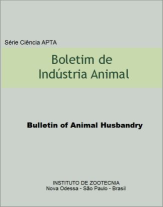Inbreeding effects on morphological and management traits in Gyr dairy cattle
Palavras-chave:
Bayesian inference, coefficient of inbreeding, zebuResumo
Bovine populations under genetic evaluation based on the BLUP method, as is the case of Gyr dairy cattle, tend to progressively use less breeding bulls, which can lead to increased relationship between individuals. It is known that morphological traits are genetically correlated with milk production, longevity and animal health, and that these are affected by the increase in homozygosity, justifying assessment of the effects of inbreeding. The main objective of this study was to estimate the effect of an increase in the inbreeding coefficient (F) on morphological and management traits in Gyr dairy cattle. A database was analyzed with a total of 2,979 animals, containing observations for 17 conformation and management traits: rump height (RH), hoof angle (HA), rump angle (RA), rump length (RL), rear teat length (RTL), milking ease (ME), rump width (RW), legs side view (LSV), udder depth (UD), temperament (TP), body length (BL), front teat length (FTL), navel length (NL), rear udder width (RUW), ischia width (IW), thoracic perimeter (TP), and legs rear view (LRV). The pedigree file used to calculate F-values for each individual contained a total of 79,538 animals. A univariate animal model was used with the Bayesian approach, considering the fixed effects of herd-year of birth of the animal, classifier, cow age (covariate); and the value of F (covariable; ranging from 0 to 100) of the animals; and random animal and residual effects. A Markov chain containing 850,000 samples was created, with burn-in of 250,000 samples and storing only 100 sample intervals (thinning), resulting in posterior distributions of 6,000 samples. The averages (and confidence intervals; 0.05 - 0.95) of posterior inbreeding effect on the traits studied were: RH= -0.08 (-0.14/-0.02), HA= -0.02 (-0.08/0.04), RA= -0.06 (-0.17/0.03), RL= -0.02 (-0.05/0.01), RTL= -0.01 (-0.03/0.01), ME= 0.003 (-0.01/0.01), RW= -0.05 (-0.10/-0.07), LSV= 0.01 (-0.01/0.03), UD= -0.02 (-0.09/0.04), TP= 0.01 (-0.009/0.02), BL= -0.07 (-0.16/0.00), FTL= -0.004 (-0,02/0.01), NL= -0.01 (-0.06/0.05), RUW= 0.002 (-0.03/0.03), IW= -0.01 (-0.04/0.01), TP= -0.11 (-0.24/0.00), LRV= 0.005 (-0.01/0.02). For most of the traits analyzed, an unfavorable effect was found with increase of F. However, in only four cases (RH, LIL, TP and BL) did the estimated confidence interval not include zero (0), thus being considered significant. Negative effects of inbreeding on morphological characteristics have also been reported by authors in the Holstein and other taurine breeds. The reduced number of animals with F-value higher than 10%, together with some probable selective phenotyping, may have caused a uncertainty in the parameter estimation.
Downloads
Downloads
Publicado
Edição
Seção
Licença
Os autores não serão remunerados pela publicação de trabalhos, pois devem abrir mão de seus direitos autorais em favor deste periódico. Por outro lado, os autores ficam autorizados a publicar seus artigos, simultaneamente, em repositórios da instituição de sua origem, desde que citada a fonte da publicação original seja Boletim de Indústria Animal. A revista se reserva o direito de efetuar, nos originais, alterações de ordem normativa, ortográfica e gramatical, com vistas a manter o padrão culto da língua e a credibilidade do veículo. Respeitará, no entanto, o estilo de escrever dos autores. Alterações, correções ou sugestões de ordem conceitual serão encaminhadas aos autores, quando necessário. Nesses casos, os artigos, depois de adequados, deverão ser submetidos a nova apreciação. As opiniões emitidas pelos autores dos artigos são de sua exclusiva responsabilidade. Todo o conteúdo deste periódico, exceto onde está identificado, está licenciado sob a Licença Creative Commons Attribution (CC-BY-NC). A condição BY implica que os licenciados podem copiar, distribuir, exibir e executar a obra e fazer trabalhos derivados com base em que só se dão o autor ou licenciante os créditos na forma especificada por estes. A cláusula NC significa que os licenciados podem copiar, distribuir, exibir e executar a obra e fazer trabalhos derivados com base apenas para fins não comerciais.













